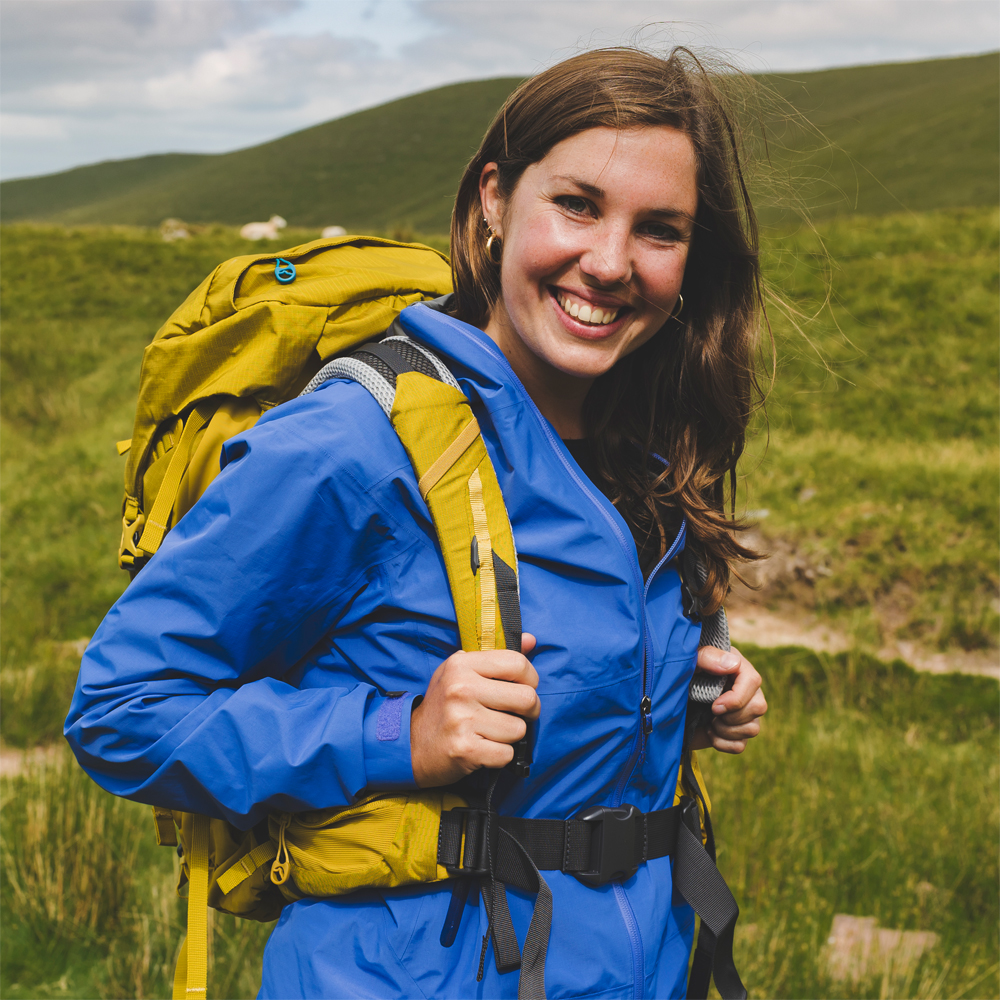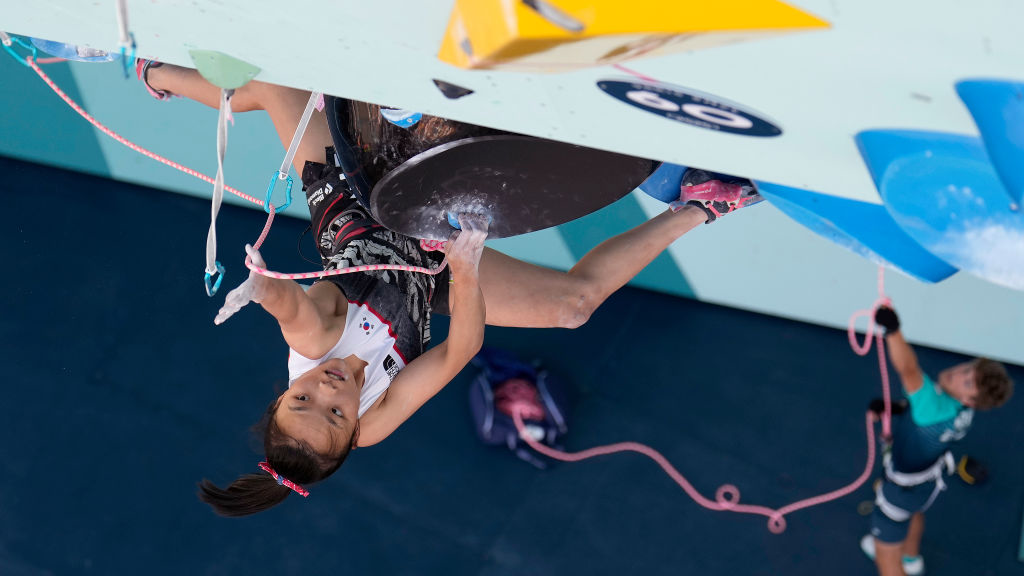The best women’s down jackets and puffers: stay warm on the trails
We've tested and rated the best women's down jackets for your backcountry adventures
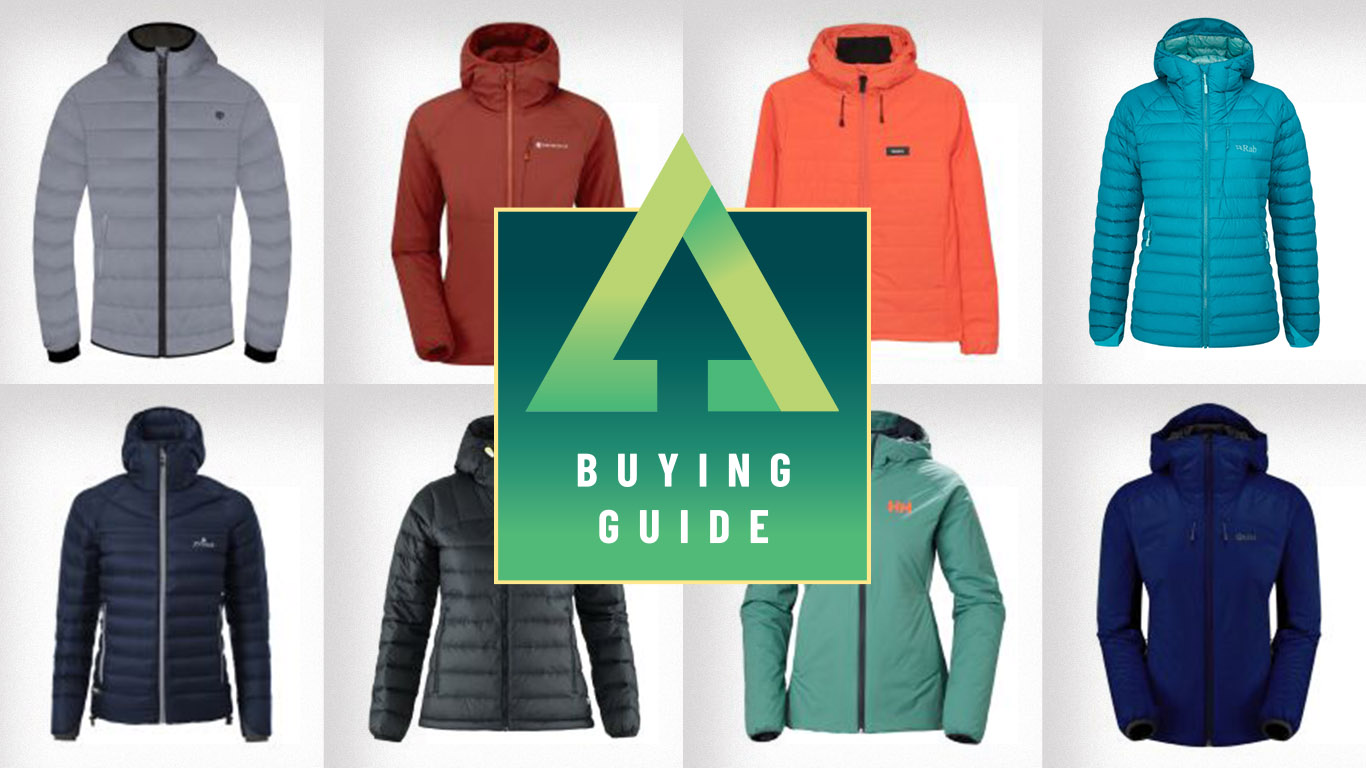
The best women's down jackets and puffers are so warm, cozy and stylish you'll want to wear them both in the backcountry and when out in town. There's undoubtedly something blissfully comforting about zipping up a quality down jacket and feeling the warmth spread across your upper body.
A puffer is an insulated jacket designed to retain your body's warmth. They can either be worn as an outer layer on dry days, or below your waterproof hardshell in harsher conditions. The insulation is provided by clusters of natural goose or duck down, or by clusters of synthetic polyester fibers. Our selection of the best women's down jackets and puffers features both natural and synthetic options.
It's worth noting that even the best down jackets are not fully waterproof, nor are they as windproof as a waterproof outer shell. Their main role is to provide insulation, which makes them great for nights in camp, chilly spring mornings and mountain summit lunch stops.
The best women's down jackets and puffers come in many forms. We've got lightweight options, perfect for the approaching warm season; a waterproof insulated parka, the ideal protection for cold weather walks; gilets for the ski resort; premium quality jackets designed for mountaineering expeditions; and reflective jackets, ideal for night missions. Whatever you choose, one of these quality insulated jackets will be a fine addition to your hiking backpack.
The best women's down jackets
You can trust Advnture
Most versatile women's down jackets
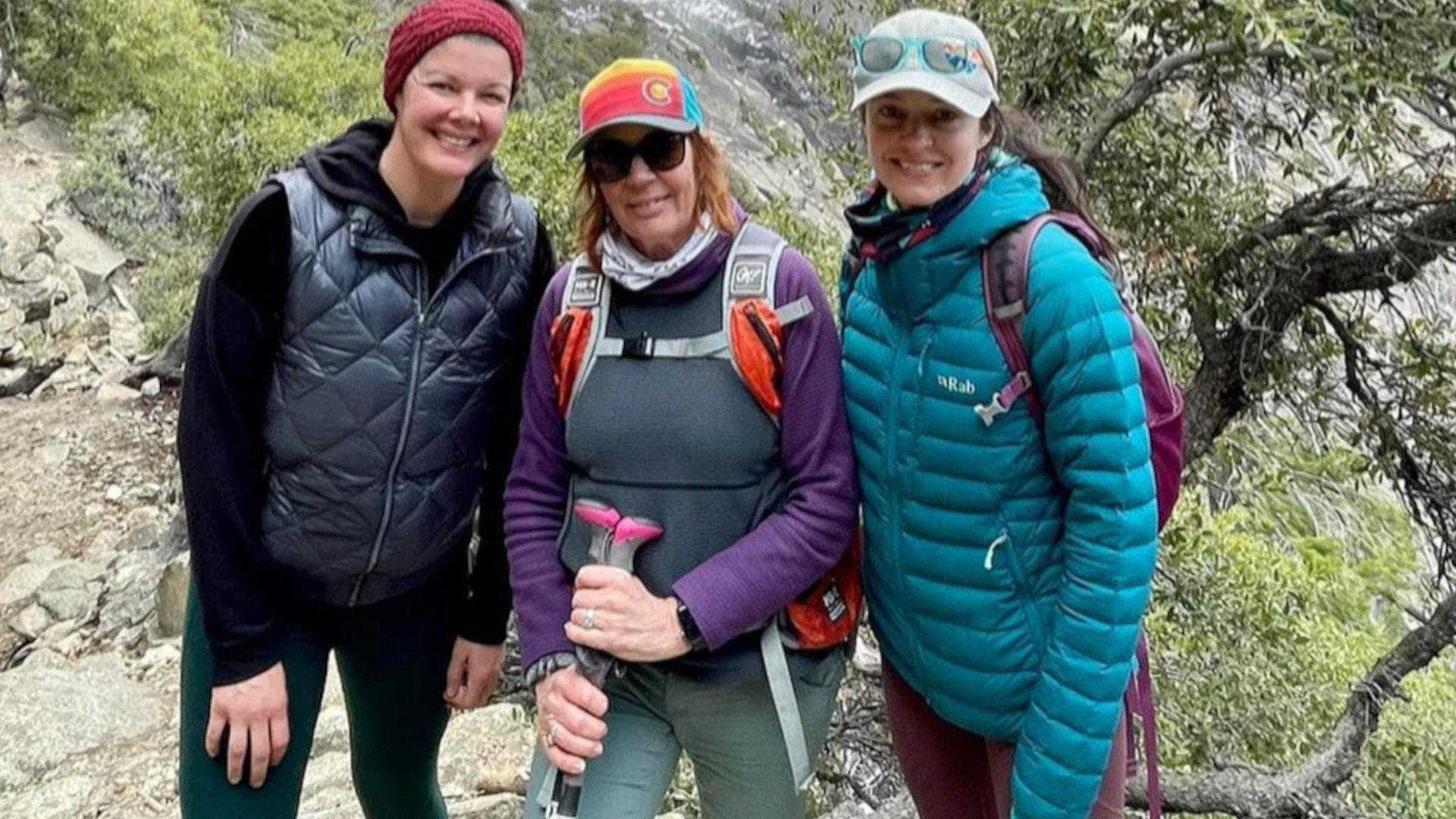
Specifications
Reasons to buy
Reasons to avoid
Typically, the main argument against down for outdoor adventures is that it doesn’t insulate when wet, but Rab has eliminated that issue by using a water resistant and windproof Gore-Tex Infinium outer so you can still wear this on damp days and stay cozy. This down jacket is filled with 700FP down making it great for adventures as cold as 32F/0C and if you are hiking in it and getting sweaty, it’s breathable too. It’s also ideal for when you stop moving and cool down, hanging out at camp, on belay or even around town when the sun dips down.
The draw cord hood stays up on gusty days with a soft chin guard to protect your skin when it’s fully zipped, while elasticated cuffs and a draw cord drop hem seal out cold drafts. Its stylish, non-bulky cut will please anyone who wants to wear it around town, but there’s plenty of room to move in it too. Rab’s commitment to sustainability shines through with the use of recycled down and if you want to hop on a plane with it, it packs down fairly small into the stuff sack provided. Competitively priced compared to other down jackets we’ve tested, we can’t find anything not to like about this jacket and think you’ll find use for it in every season.
Read our full Rab Infinity Microlight Down Jacket review
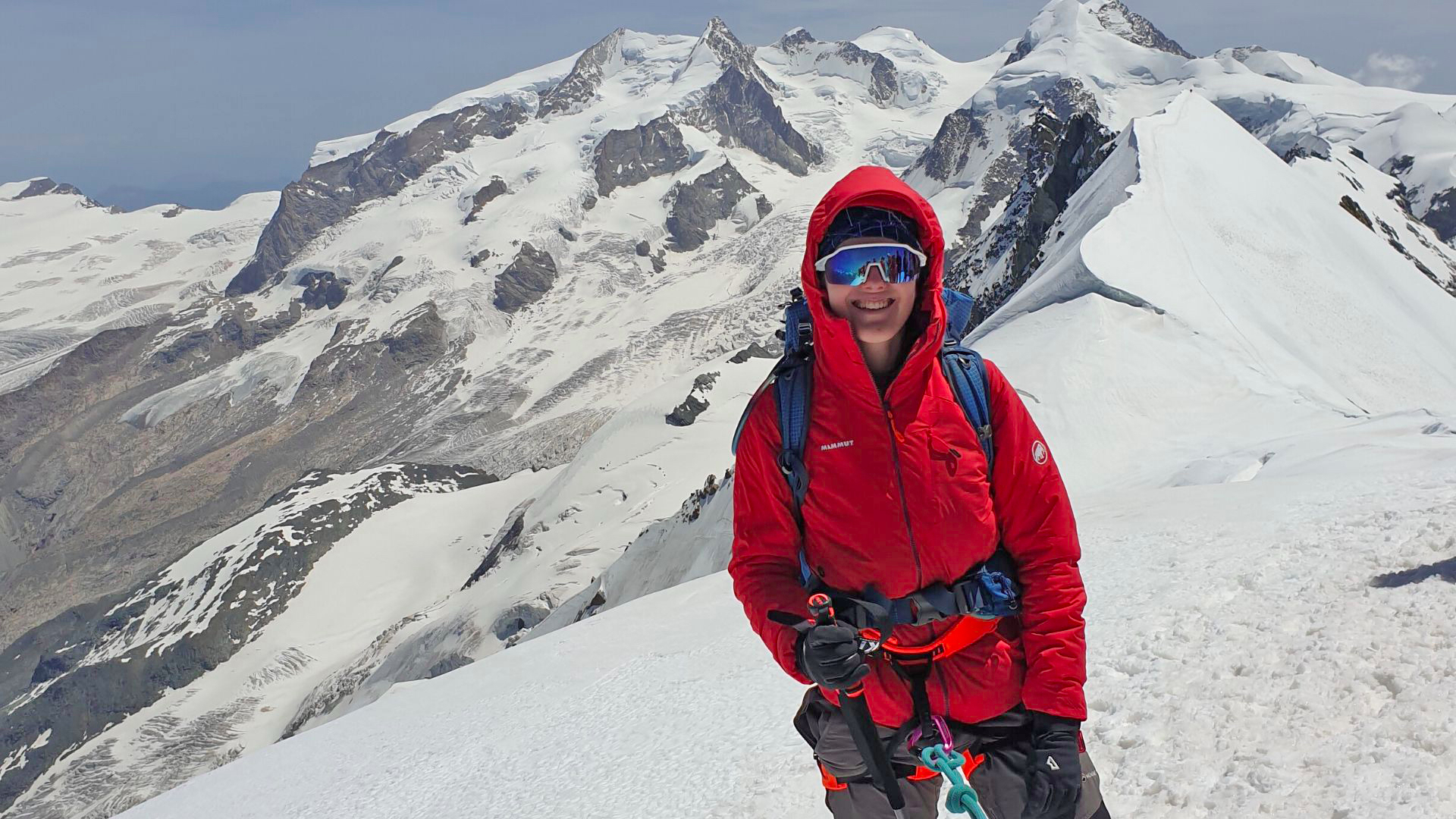
Specifications
Reasons to buy
Reasons to avoid
The Mammut Rime In Flex Hooded Jacket is a synthetic-fill insulated jacket with an alpine cut and feel. The jacket is currently the warmest of its type in Mammut’s range, making it a great choice for cold, damp days or summer alpinism. The outer shell is a lightweight but hard-wearing nylon fabric and the lining is made of Pertex Quantum Air. The filling is a combination of recycled polyester fibres and renewable plant fibers. The jacket has two decent sized zip pockets at the waist and a small chest pocket, also with a zip.
The jacket hood is big enough to take a helmet, with an adjustable elastic and toggle at the back of the head. The peak is stiffened and held in place on the head with an elasticated mesh. This means the hood can adapt to stay snuggly on your head without the faff of adjusting front draw cords. A similar use of elasticated cuffs makes for a simple but stylist cut without the need for velcro. Toggled elastic also allows you to cinch in the bottom of the jacket to keep the wind out. The outer shell offers wind resistance and light waterproofing. It won’t stay dry in a downpour, but at least it will still keep you warm.
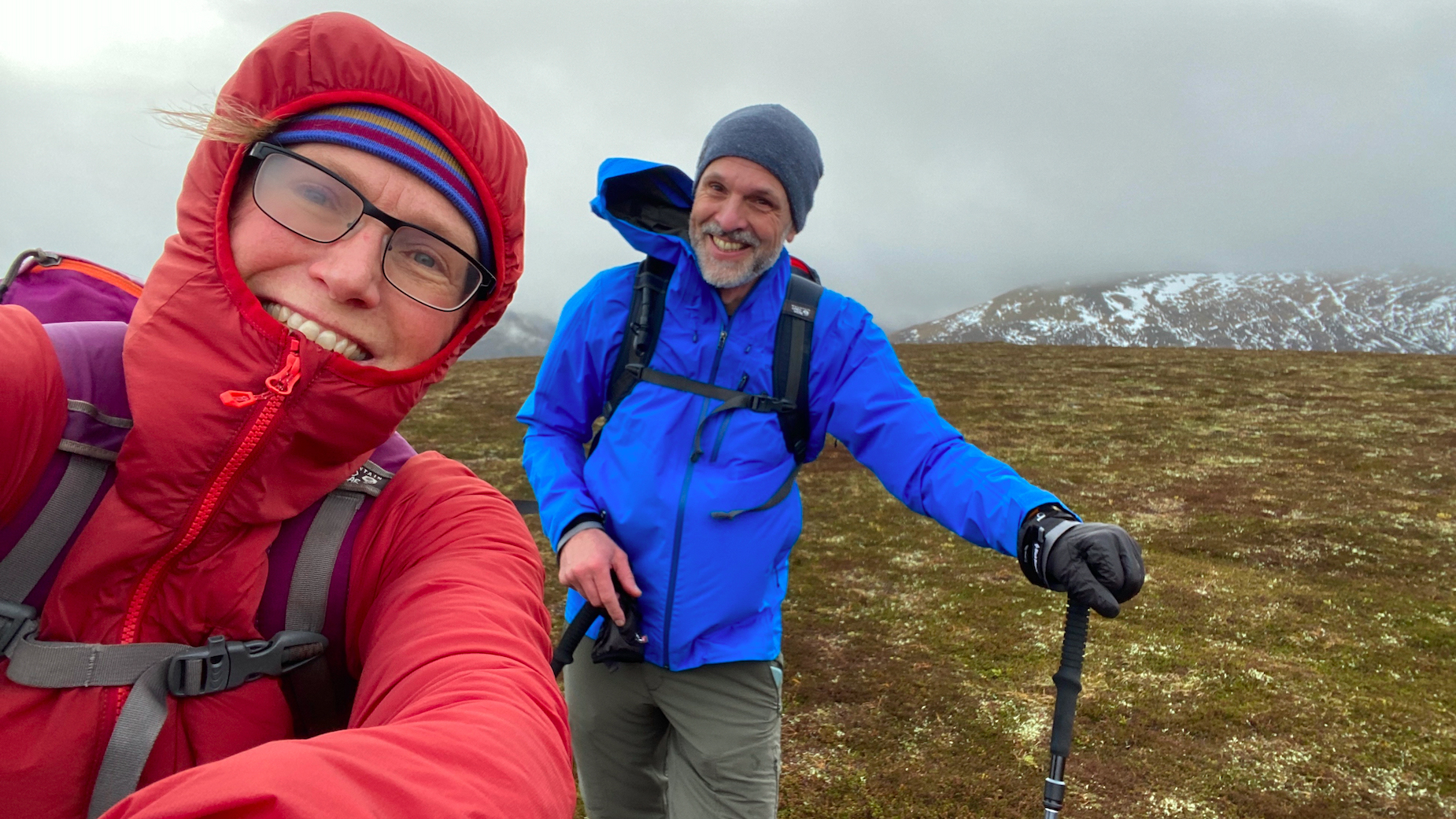
Specifications
Reasons to buy
Reasons to avoid
The Montane Fireball jacket is a midlayer insulated jacket, which means you might typically wear it over a base layer and under a waterproof jacket. It also offers good warmth as a stand-alone jacket on warmer weather days if you are heading out on trails or into the hills. It’s a useful jacket for trail runners and walkers, because you can stuff it into a small space in a pack and pull out when you need a bit of extra warmth, for example at higher altitude or when stopping for a breather or a bite to eat. Montane has created the jacket with 55% recycled Clo Vivo Extreme Eco synthetic insulation with the aim of maximising warmth and breathability yet still keeping the product lightweight.
The insulation is also designed into the ‘under helmet’ hood. This means you have a warm and insulated hood that can be useful whether you need to wear a helmet or not. The outer and inner fabrics are a two-way stretch fabric. Montane calls this material Featherlite Air Nylon, which is aimed at giving a good level of additional breathability, as well as freedom of movement when running or hiking. The addition of a DWR (Durable Water Repellent) treatment to the outer fabric provides protect against light rain but this does not mean it will be waterproof in heavier or consistent downpours.
The design incorporates articulated arms so that you can reach higher without losing warmth at the wrists. Low build elasticated cuffs keep down the weight of the jacket without compromising on usefulness. There are some useful extra features including two hand-warmer zipped pockets, an external zipped chest pocket and an adjustable hem with cinchable drawcord.
The best women's parkas
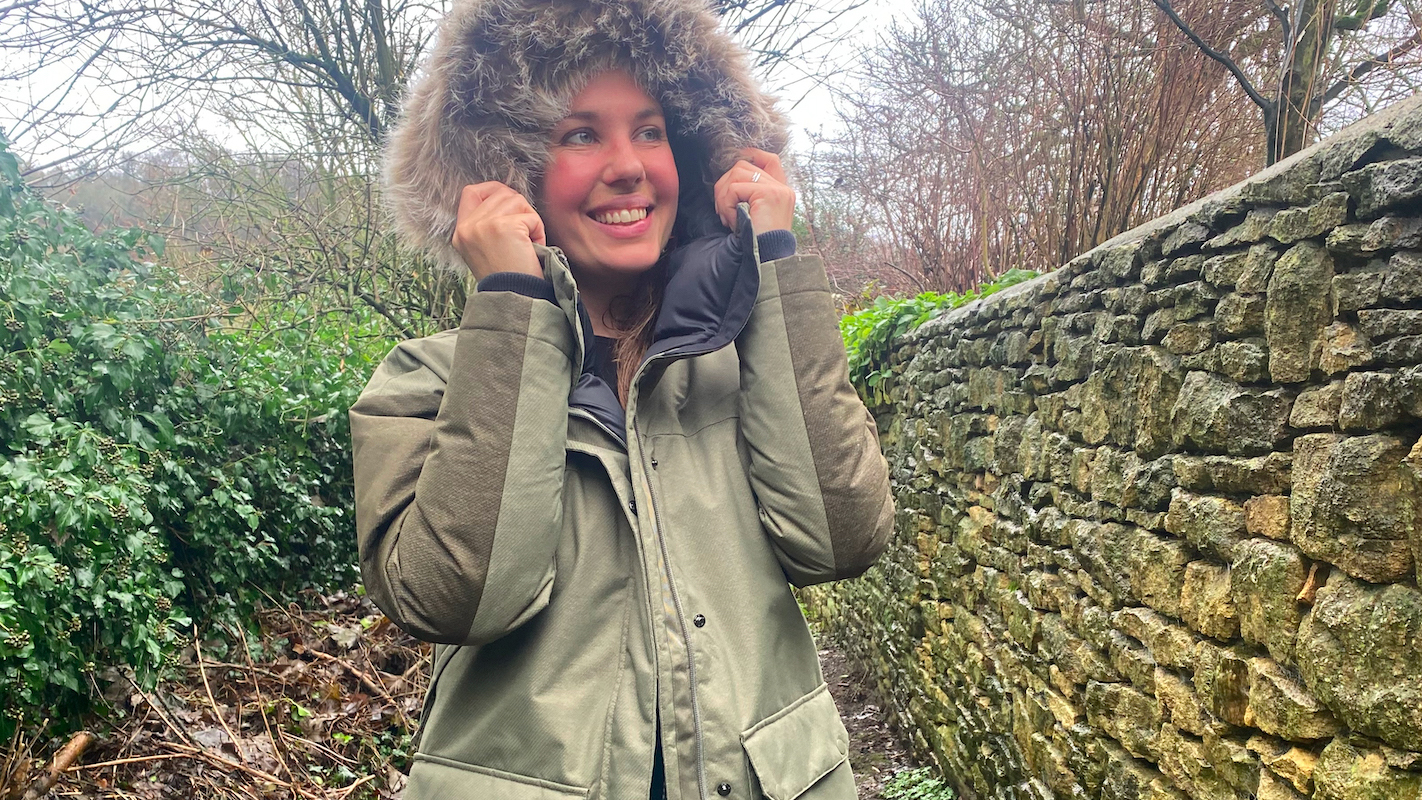
Specifications
Reasons to buy
Reasons to avoid
When the weather outside is frightful, cosy up in this warm and waterproof parka that’s packed with enough down to feel like you’ve got your duvet wrapped around you. Columbia’s Mount Si Parka has accumulated lots of fans for its combination of cosy comfy warmth and tough waterproofing. A clever liner traps in body heat – and this feature combined with a generous fill of (RDS certified) duck down makes the Mount Si a very warm coat indeed. In fact, while it’s ideal for wearing while you’re out and about on frosty mornings and chilly star-spangled evenings, it can be a little too hot when the days warms up, and it’s not really breathable enough to wear while engaged in energetic activities outside of midwinter. A waterproof membrane stops snow and rain in their tracks, however, and the coat’s longer length adds even more warmth and protection.
Read our full Columbia Mount Si Down Waterproof Parka review
Down jackets for mountaineering
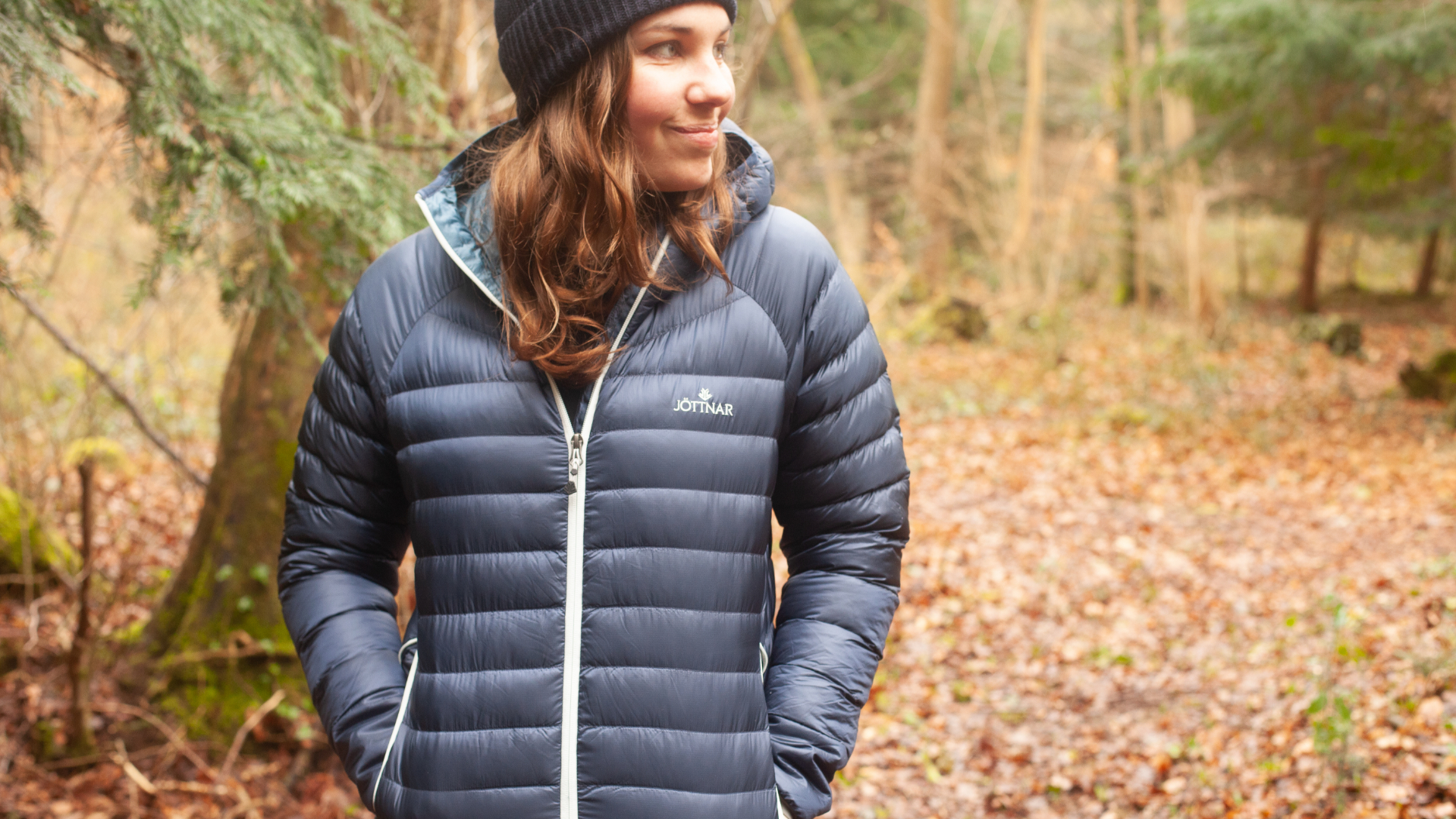
Specifications
Reasons to buy
Reasons to avoid
Jottnar’s outdoor pieces are designed with mountaineers in mind and named after mighty Norse gods, and the tough Fenrir (a mythological wolf) is one of the brand’s standout down jackets.
We tested the Fenrir over a year of hiking and mountain adventures and found ourselves reaching for this versatile mid layer again and again. It’s lightweight and packable, squishing down into its own stuff sack for easy transportation, but offers fantastic warmth thanks to animal down that meets the Responsible Down Standard.
The Fenrir works both as a mid layer under a waterproof shell and as an outer jacket on cold-but-dry days. The fit is perfect; the jacket is not restrictive anywhere and allows good freedom of movement. An adjustable hood keeps your face and head cosy, and a dropback hem warms the lower back and stays put when the Fenrir is worn with a backpack. The outer material is also water-resistant enough to bead off light rain. Well worth the spend if you get outside all winter long.
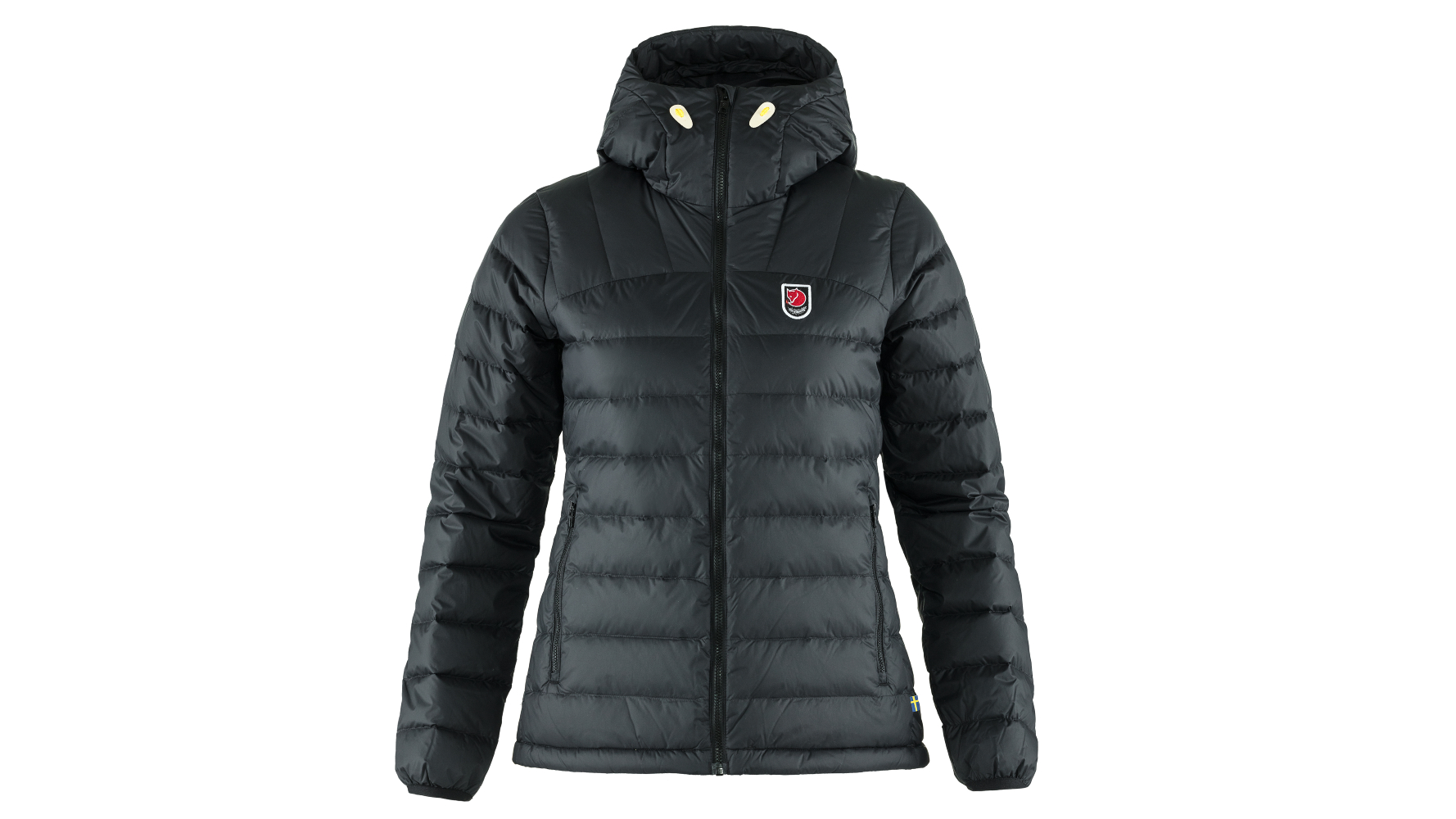
Specifications
Reasons to buy
Reasons to avoid
Most of Fjällräven’s down jacket offerings are huge coats designed for Arctic conditions – this Expedition Pack Down model is far more slim, packable and versatile. We tested it out when hiking in the Dolomites (you may also want to check out our look at the Best Women’s Hiking Boots) in both sun and snow, and really rated its reliable warmth and great fit, which makes it comfortable to wear mile after mile.
Like all outdoor clothing from Swedish brand Fjällräven, whose motto is ‘functional, durable, timeless’, there are good eco credentials here. The down used is ethically sourced and the outer material is fully recycled. The waistband is easy to adjust with a cord hidden inside the pocket, and we also like the adjustable hood, which is warm and flattering, and the handy inner pocket for stashing your phone.
While the Expedition doesn’t pack as small as some other jackets on this rundown of the best women’s down jackets and puffer jackets, you can squash it to the size of a large pencil case, so it’s still easily transportable in your backpack. We also love the retro looks of the jacket, which are inspired by Fjällräven’s first down coats designed in the 1970s. Colorways range from sunshine-bright yellow or red to more toned-down navy or black.
The best ultralight down jacket
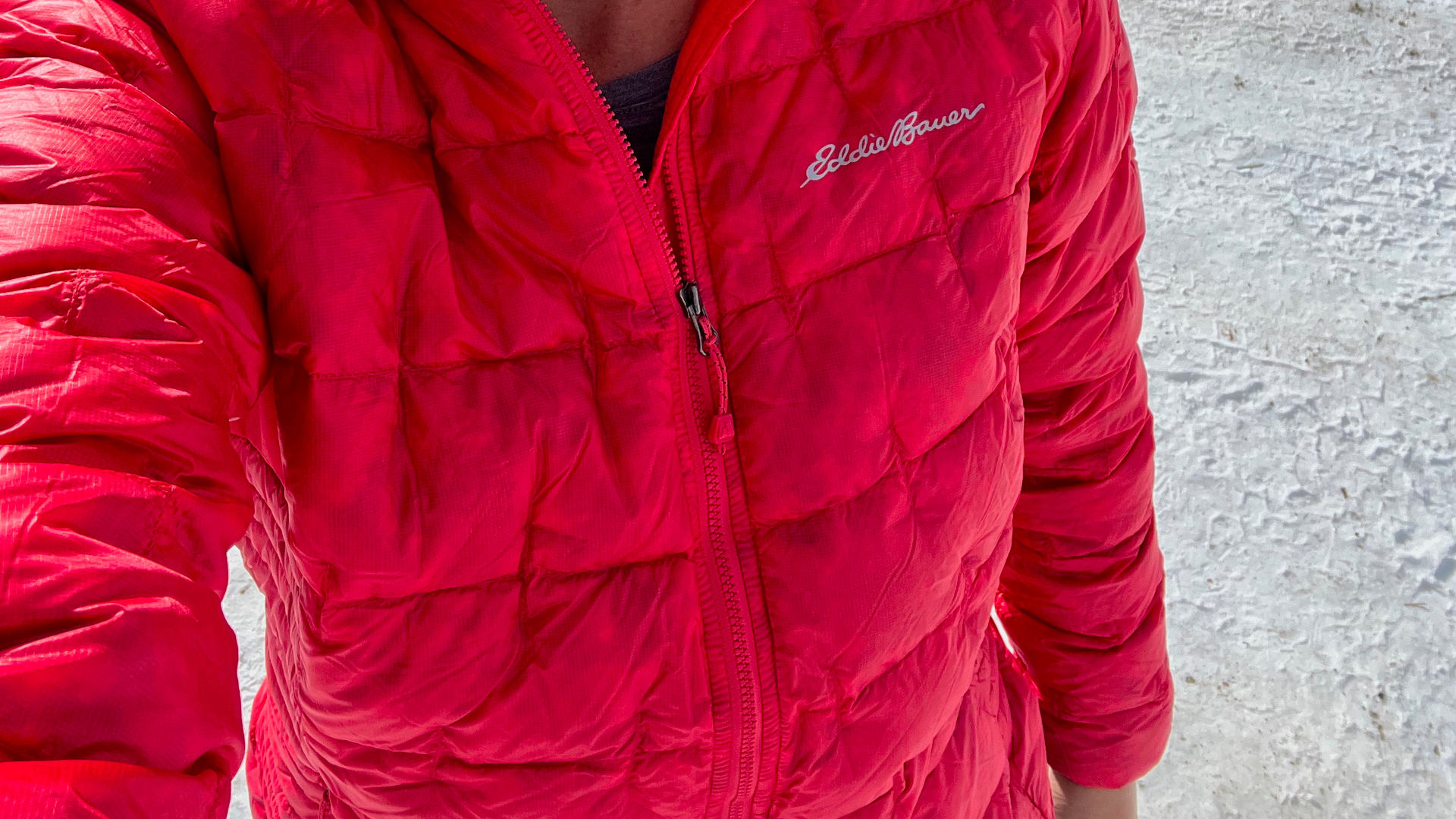
Specifications
Reasons to buy
Reasons to avoid
It’s common to have to choose between weight and warmth when it comes to picking a down jacket. However, the Eddie Bauer MicroTherm 1000 Down Hoodie is not only ultra lightweight, it’s also ultra warm. These two top qualities, paired with the puffy jacket’s durability and packability, made it a top choice for on-the-go and weather-variable outdoor adventures like backpacking.
The 1000-fill goose down insulation is Responsible Down Standard (RDS)-certified, making it more ethical, and super lofty within larger panels throughout the jacket. It’s most common to see down jackets and sleeping bags at a 650-fill standard or even up to 850-fill, but it’s rare to see 1000-fill because down clusters rarely get this full in their fluff. Aside from the spacious panels on the front and back of the jacket, the more narrow and stretchy panels on the sides of the jacket, along with a lightweight performance fleece material under each armpit, allows for more freedom of movement and air flow.
The Eddie Bauer MicroTherm 1000 Down Hoodie has two external hand pockets and one internal pocket on the lower right side, along with a zippered internal pocket on the upper left chest. The down jacket stuffs into itself for easy storage in this upper side pocket which has a reversible zipper.
Some ultra-lightweight down jackets are more delicate, but this one is durable with a recycled ripstop nylon with a DWR treatment for moisture shedding. The fit is athletic and hugs the body, so it can act as a midlayer, and the stretchy nature of the jacket still allows for great movement.
Lightweight synthetic down jackets
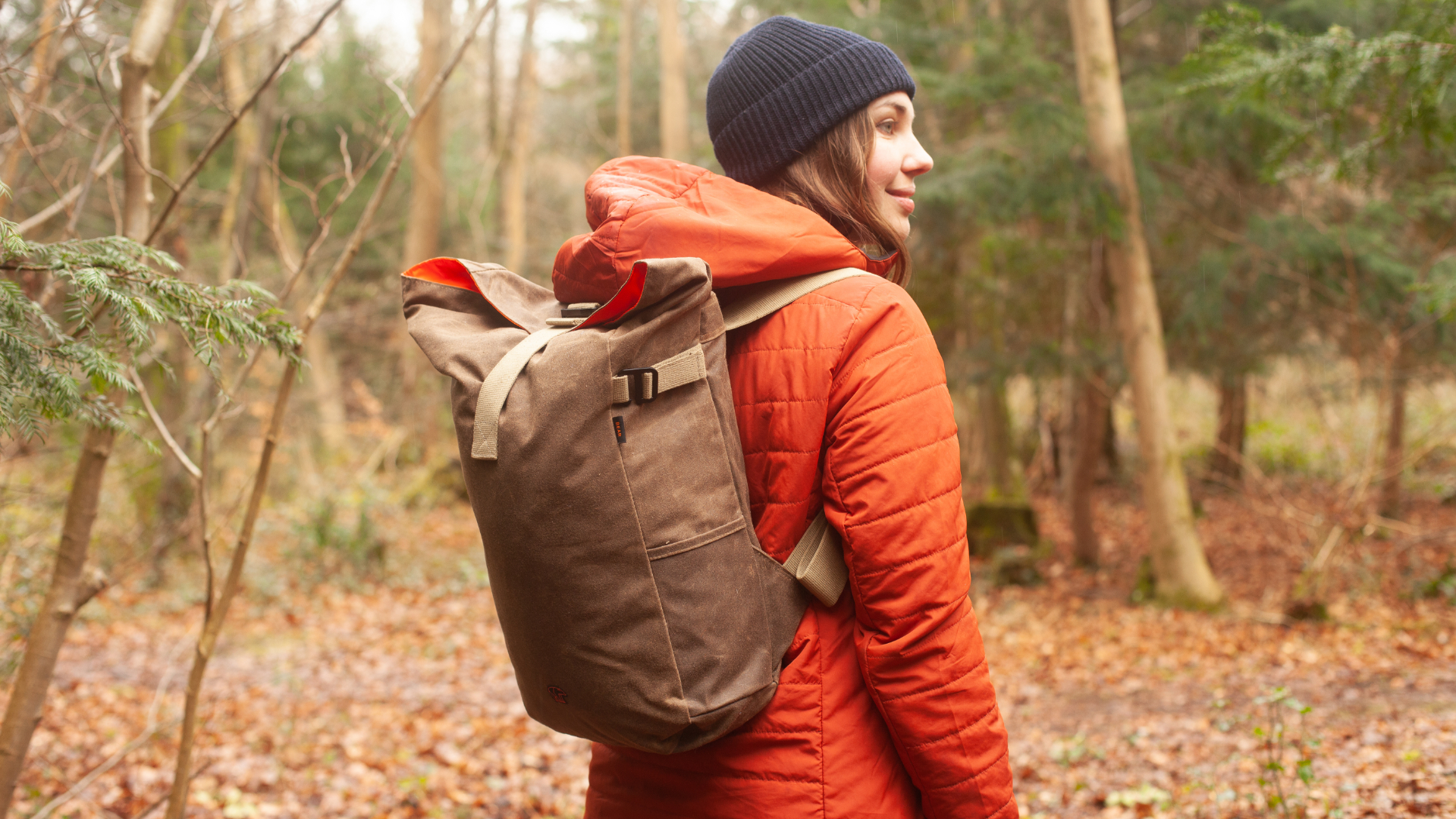
Specifications
Reasons to buy
Reasons to avoid
The Nimbus is Finisterre’s bestselling women’s insulated jacket, and for good reason. There’s lots to like here, not least the jacket’s smart looks and earthy colorways. The Nimbus is slim-fitting and bulk-free, but it’s not as warm as more padded jackets, making it best suited for use as a light jacket on spring walks or for wearing under a shell on coastal hikes.
This jacket is firmly in the casual camp, but the lack of bulk coupled with a great cut makes the Nimbus work brilliantly over a fleece or sweater and under a waterproof for daily wear. There are other nice design touches here, such as a fleece-lined collar and an adjustable hood, and the Nimbus packs down into its own chest pocket, ideal for carrying with you on walks or on the commute, but it’s a pity the pockets aren’t zipped.
In line with Finisterre’s ocean-loving ethos, the filling, material and zip are all recycled, which definitely gets our vote.
Winter synthetic down jackets
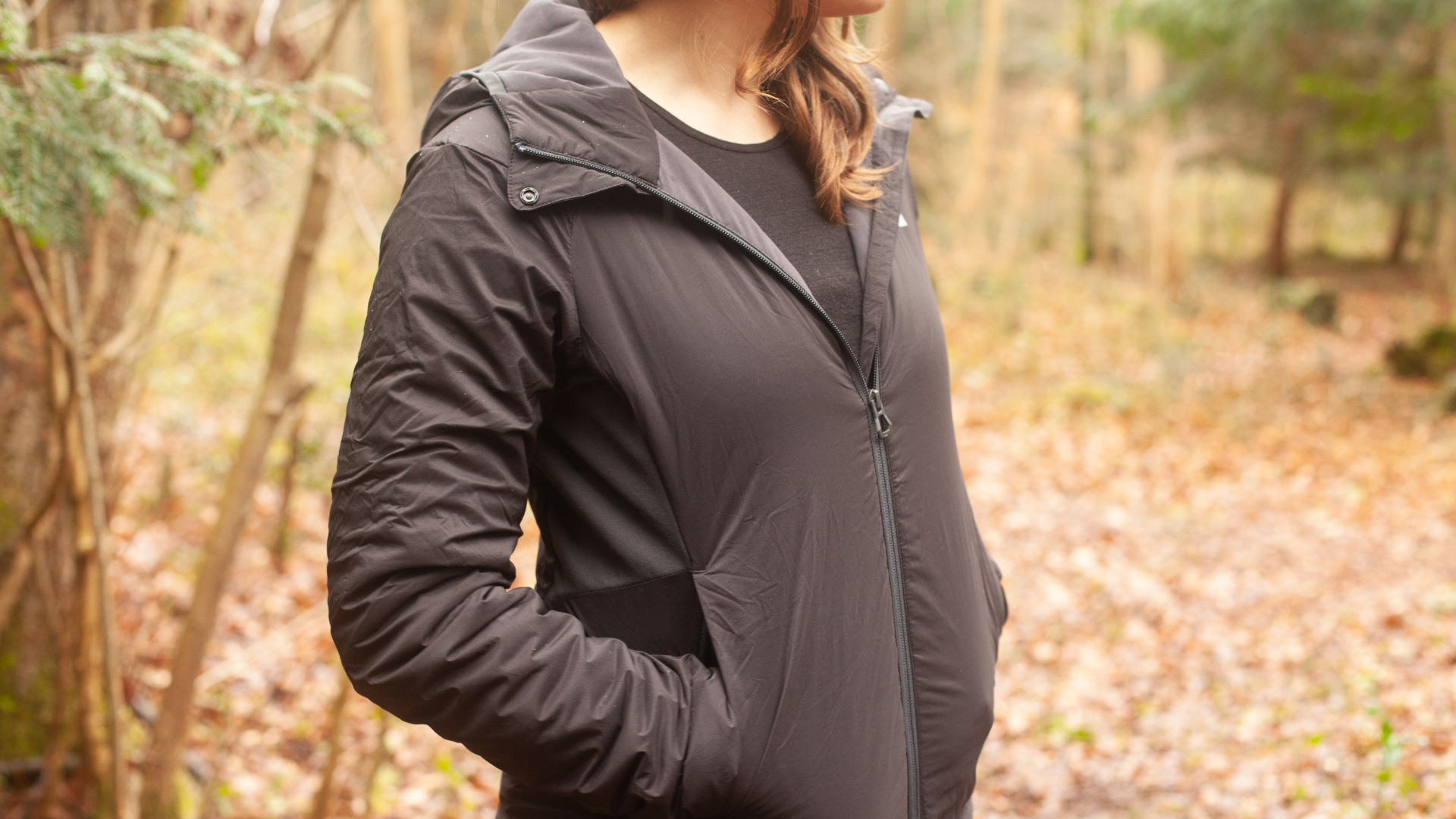
Specifications
Reasons to buy
Reasons to avoid
If you hate the Michelin-man puffy looks of most insulated jackets, you’ll love Helly Hansen’s sleek Odin. Popular with ice climbers and hikers alike, this light jacket has insulation but no quilting, allowing for easy layering without any added bulk or restriction of movement.
We’re not sure the jacket is stretchy enough to deserve its Stretch title, as the only give is in the small panels under the arms. That said, these insulation-free sections do allow for better unimpeded movement of the arms when you’re climbing or scrambling.
On test we rated the soft fleecy inner lining, which feels comforting in the cold, plus the easily adjustable waist and comfy high neck. The outer material is also waterproof enough to repel light rain and snowfall. We tested out the black version of the Odin, which is easy to wear everywhere from city streets to hillside trails.
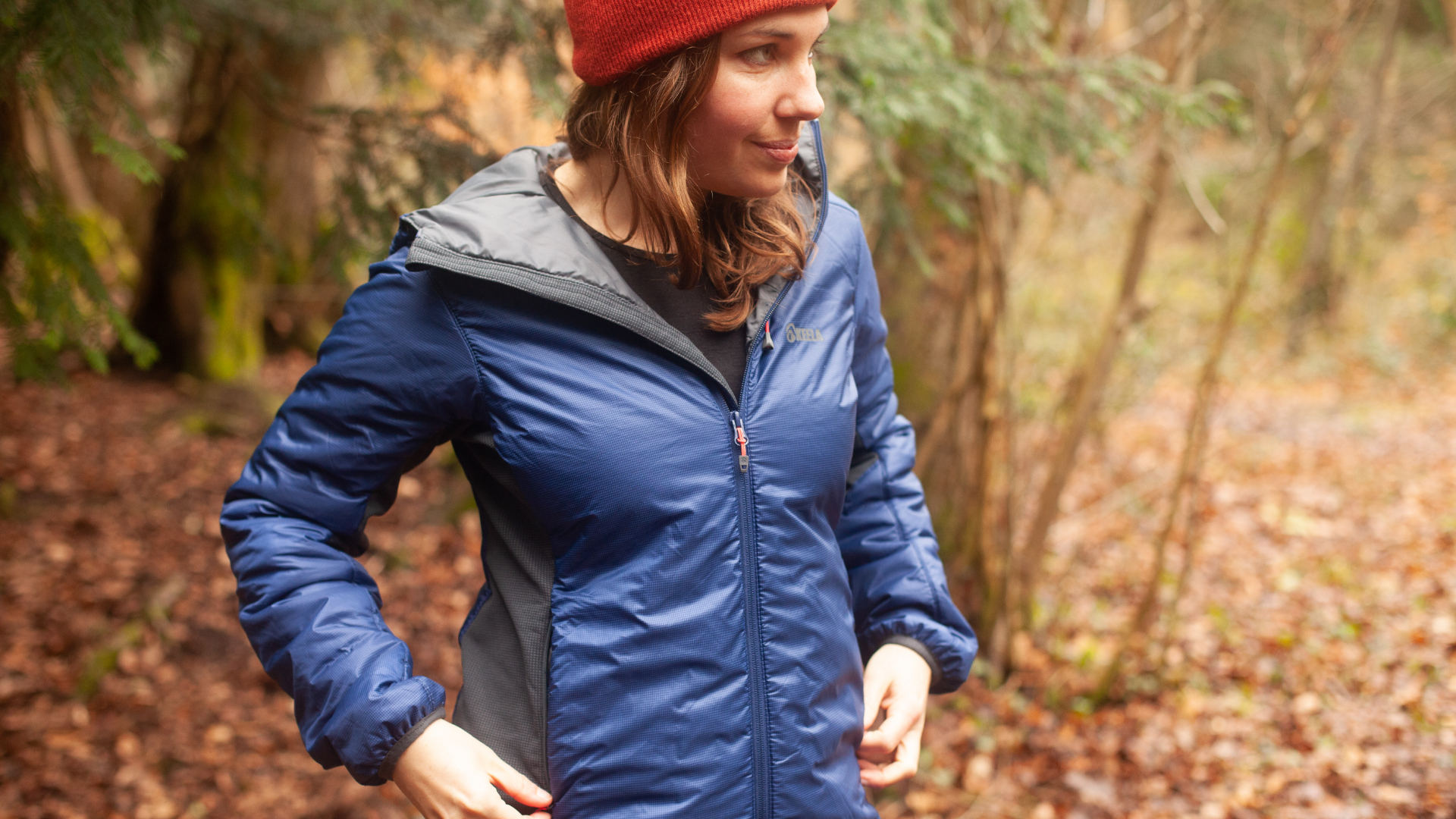
Specifications
Reasons to buy
Reasons to avoid
The Talus is the workhorse of our round-up of the best women’s down jackets and puffer jackets. Its ripstop outer material is far more resistant to tears and scratches than most down jackets (which can often rip at the slightest brush with a thorn) and you can tell this jacket was designed in Scotland, where four seasons in a day are likely – we found it water-resistant enough to put up with sudden rain, and it still offers warmth when damp, and dries quickly.
It’s also windproof enough to cut chill, making it a great standalone jacket on warmer days. Flexible, fleece-lined panels run all the way up the inside of the arms and offer great freedom of movement; coupled with a lighter dose of synthetic insulation, these make the Talus ideal for sports.
A reinforced peaked hood keeps water and sun out of your eyes and is also compatible with a helmet. The Talus’ fit runs small, and we’d advise going up a size if you want to wear more than a base layer underneath.
Down jacket for belaying
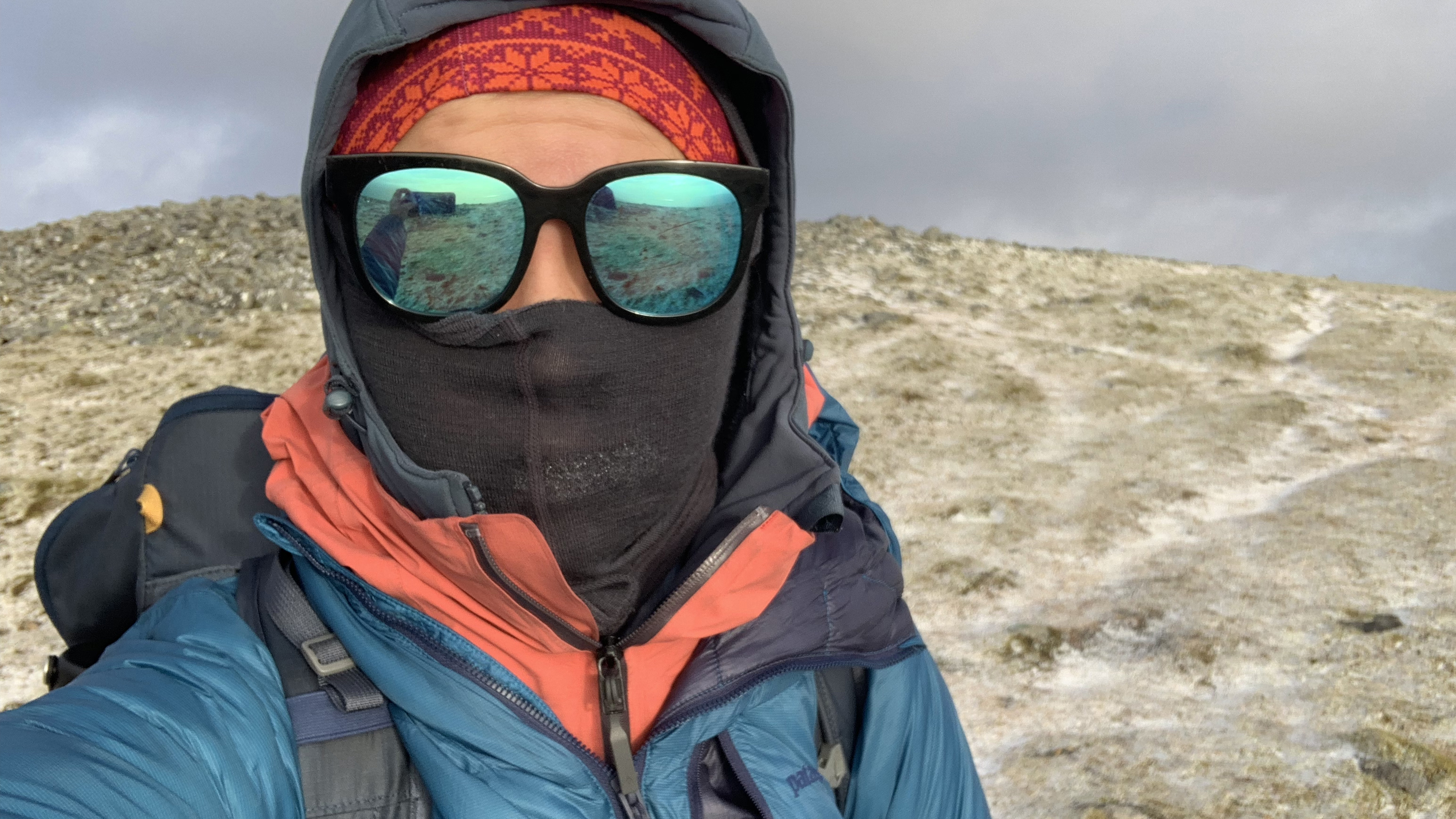
Specifications
Reasons to buy
Reasons to avoid
The Patagonia Women’s DAS (‘Dead Air Space’) Hoodie Light is an ultralight hooded jacket for keeping warm when you’re playing in the mountains in spring, summer and autumn alpine conditions, whether you’re moving fast up a slope or hanging at the bottom of the crag belaying a buddy. The Pertex Quantum material provides a decent level of abrasion resistance when worn as an outer later, alongside windproof nylon. It’s a versatile jacket which can also stretch to use on milder winter days when worn as a midlayer, as its construction mimics that of down (although the fill is recycled synthetic fibres).
However, it really comes into its own as a great, light, super packable jacket for cold draughty belays, where pack size and weight are major concerns. Being a Patagonia product, the green and ethical credentials are particularly transparent and highend, with the brand using Fair Trade Certified materials in factories that pay a fair wage.
The best women's down gilet
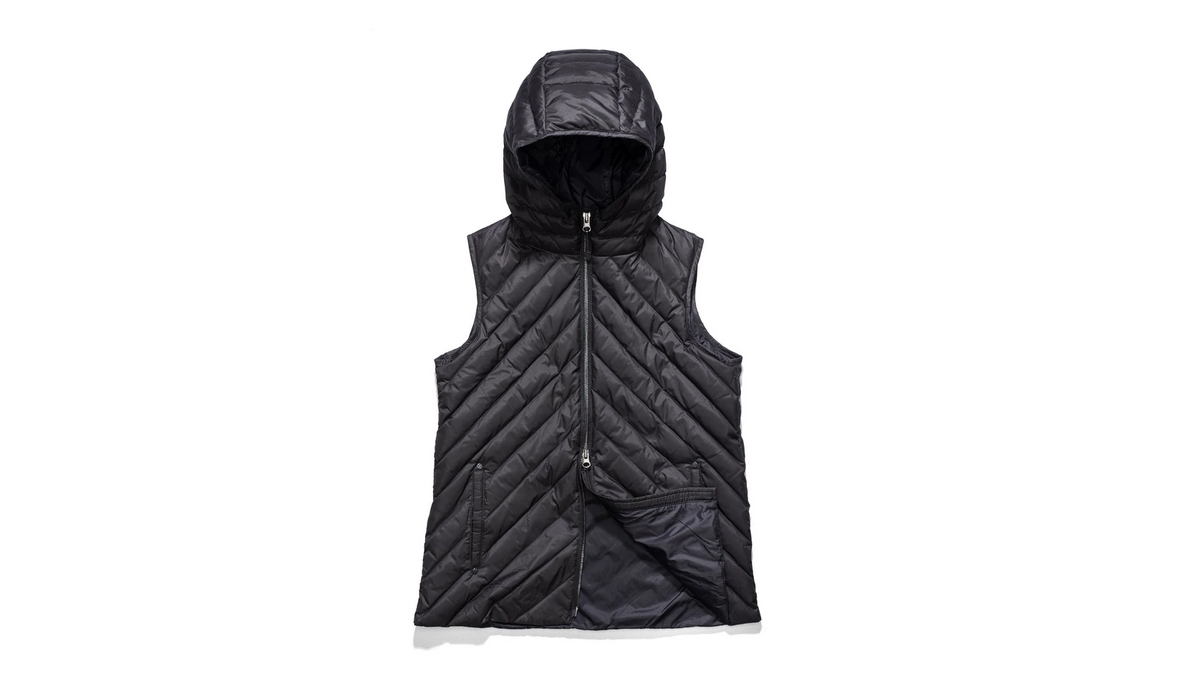
Specifications
Reasons to buy
Reasons to avoid
One way to keep your torso warm without overheating when you’re out getting active is to pick an insulated bodywarmer rather than a jacket. The Nobis Lily is our top choice if you’re in the market for a gilet (insulated vest) – it’s so light you’ll barely notice you have it on, but it does a brilliant job of warming you up without weight and still lets the body breathe, thanks to warm duck down sourced from Canada as a by-product of the poultry industry.
Ideal for keeping warm without hindering movement, it’s very easy to layer with, and we found it ideal for fast-paced activities where you work up a sweat but are still likely to feel the cold as soon as you stop, such as snow sports. Whether or not you like the look of a gilet, the simple Lily is very easy to wear anywhere. A pity it’s so expensive – one to snap up in a sale.
Down jackets for night adventures
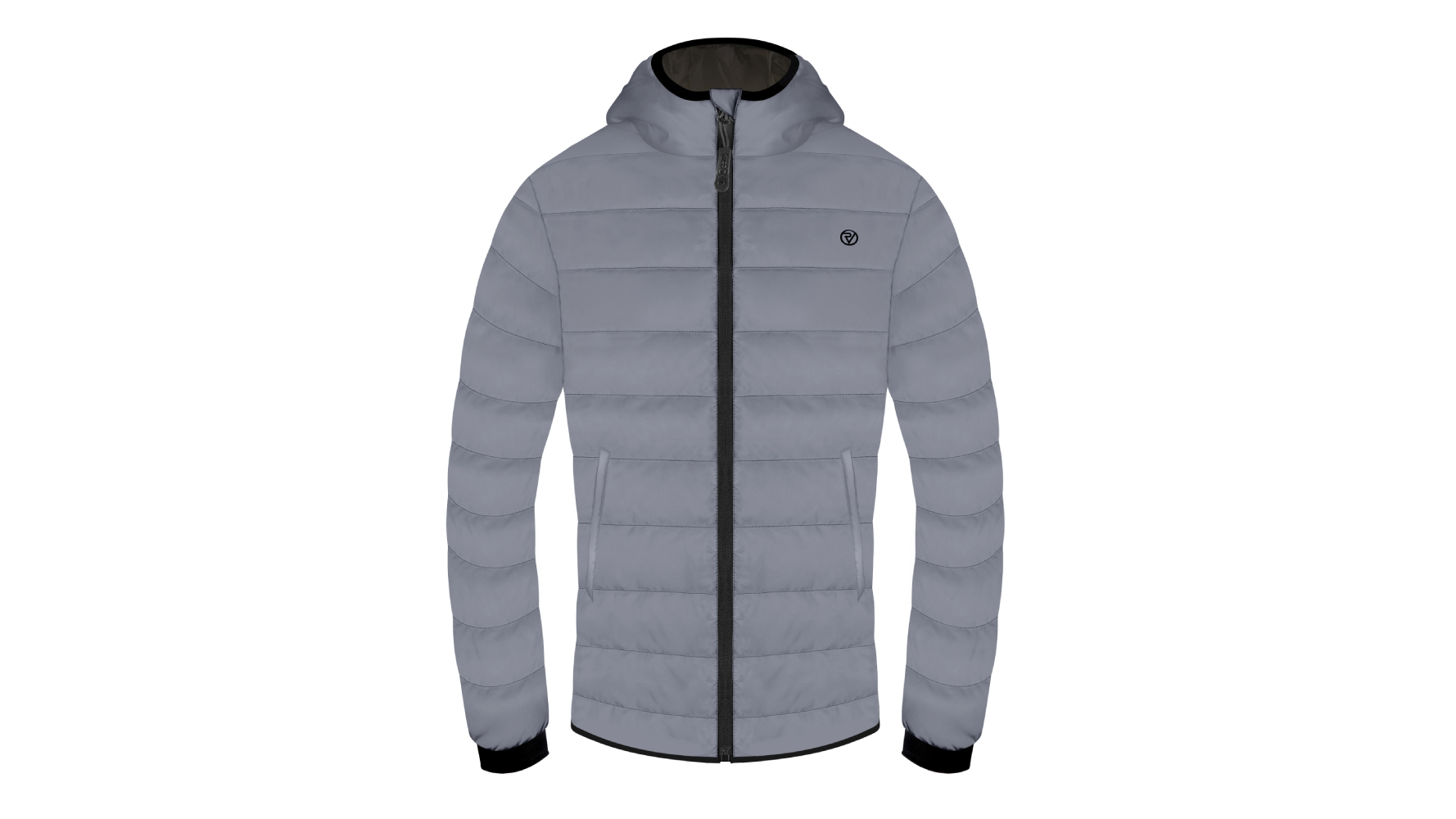
Specifications
Reasons to buy
Reasons to avoid
Stay bright and visible at night in this (literally) eye-catching down jacket. We’ve been wearing Proviz’s excellent reflective shell cycle jackets for years, so we were pleased to see a warmer down jacket added to the brand’s line-up.
The reflective outer material is coated in thousands of tiny beads that bounce back light and make you very visible in any light source (such as car headlights), ideal for anyone out exploring at night. In daylight, the 360 jacket is a smart silver/grey.
The jacket also stood out on test for its comfortable long and boxy cut, which keeps more of your torso warm and allows for easy layering. The jacket is insulated with real down (of unknown provenance, sadly, as it’s always better to know whether down has been sourced ethically) and while it’s not super lightweight or breathable at 600g, it does instantly trap heat and warm you up in chilly conditions. Save it for being seen in the bitter cold rather than for more aggressive hikes and cycles.
| Down jacket | Price | Weight | Style | Best use |
| Rab Infinity Microlight | $280 (US) / £240 (UK) | 452g/15.9oz (Size M) | High performance down jacket | Winter and shoulder seasons: hiking, backpacking, climbing, winter and alpine mountaineering |
| Mammut Women’s Rime In Flex Hooded Jacket | $289 (US) / £225 (UK) | 450g / 16oz | High performance synthetic puffer | Winter and shoulder seasons: hiking, backpacking, climbing, winter and alpine mountaineering |
| Montane Fireball jacket | $260 (US) / £200 (UK) | 345g / 12oz | Insulated synthetic mid layer | 3-season use: climbing, hiking, trail running |
| Columbia Mount Si Down Waterproof Parka | $350 (US) / £345 (UK) | – | Waterproof, insulated parka | Winter and shoulder season hiking |
| Jöttnar Fenrir | $409 (US) / £295 (UK) / €335 (EU) | 250g / 8.8oz | High performance goose down jacket | Winter and shoulder seasons: hiking, backpacking, climbing, winter and alpine mountaineering |
| Fjällräven Expedition Pack Down | $373 (US) / £269 (UK) / €310 (EU) | 435g / 15.3oz | High performance down jacket | Winter and shoulder seasons: hiking, backpacking, skiing, climbing, winter and alpine mountaineering |
| Eddie Bauer MicroTherm 1000 Down Hoodie | $399 (US) | 284g / 10oz | Lightweight down jacket | Winter and shoulder seasons: hiking, backpacking, skiing, climbing, winter and alpine mountaineering |
| Finisterre Nimbus | $228 (US) / £165 (UK) | 400g / 14oz | Lightweight synthetic insulated jacket | All year round: hiking, backpacking, hut-to-hut trekking, climbing |
| Helly Hansen Odin Stretch Insulator | $277 (US) / £200 (UK) / €230 (EU) | 460g / 16.2oz | Synthetic puffer jacket | Winter and shoulder seasons: hiking, backpacking, climbing, skiing, winter walking |
| Keela Talus | $194 (US) / £140 (UK) | 500g / 17.6oz | Synthetic puffer jacket | Winter and shoulder seasons: hiking, backpacking, climbing, skiing, winter walking |
| Patagonia Women’s DAS Light Hoodie | $329 (US) / £320 (UK) / €350 (EU) | 270g / 9.5oz (Small) | High performance synthetic puffer | 3-season use: climbing, hiking, alpine mountaineering |
| Nobis Lily | $450 (US) / £325 (UK) | 290g / 10.2oz | Down gilet (insulated vest) | Winter and shoulder seasons: hiking, backpacking, climbing, skiing, winter walking |
| Proviz 360 Reflective | $236 (US) / £170 (UK) | 600g / 21.2oz | Reflective down jacket | Winter and shoulder seasons: hiking, backpacking, cycling, climbing, winter and alpine mountaineering — perfect for us at night |
How to choose a women's down jacket
1. Insulation
Insulated jackets use either animal down or synthetic insulation to trap in heat and keep you warm. Animal down, usually derived from duck or goose down (down are the clumps of fine feathers found under a bird’s tougher exterior feathers) offers a brilliant warmth-to-weight ratio in dry cold weather, but is useless when wet. Brands using animal down will also list the ‘fill power’ of a jacket, such as 400, 600 or 800. The higher the fill power, the warmer the jacket is likely to be. Animal down was traditionally warmer than synthetic insulation, but synthetic materials are rapidly catching up. Synthetic insulation has other benefits – it still offers some warmth when wet, it dries faster and it can be made using recycled materials.
There’s also an animal welfare issue with the production of some animal down jackets. The cheapest down may be harvested from live animals, a cruel and unnecessary act. You’ll see other down jackets labelled as ‘humanely harvested’, which means the down is a by-product of food production. You can also choose to purchase ethically sourced down (look for the RDS, or Responsible Down Standard, used to denote down obtained from animals that have not been subjected to unnecessary harm) – here's everything you need to know about ethical down for jackets and sleeping bags.
Synthetic down jackets avoid the problem all together, and we’d recommend spending a little more on a jacket that either uses synthetic insulation or humane, traceable down. You can learn more in our Down vs synthetic fibre guide.
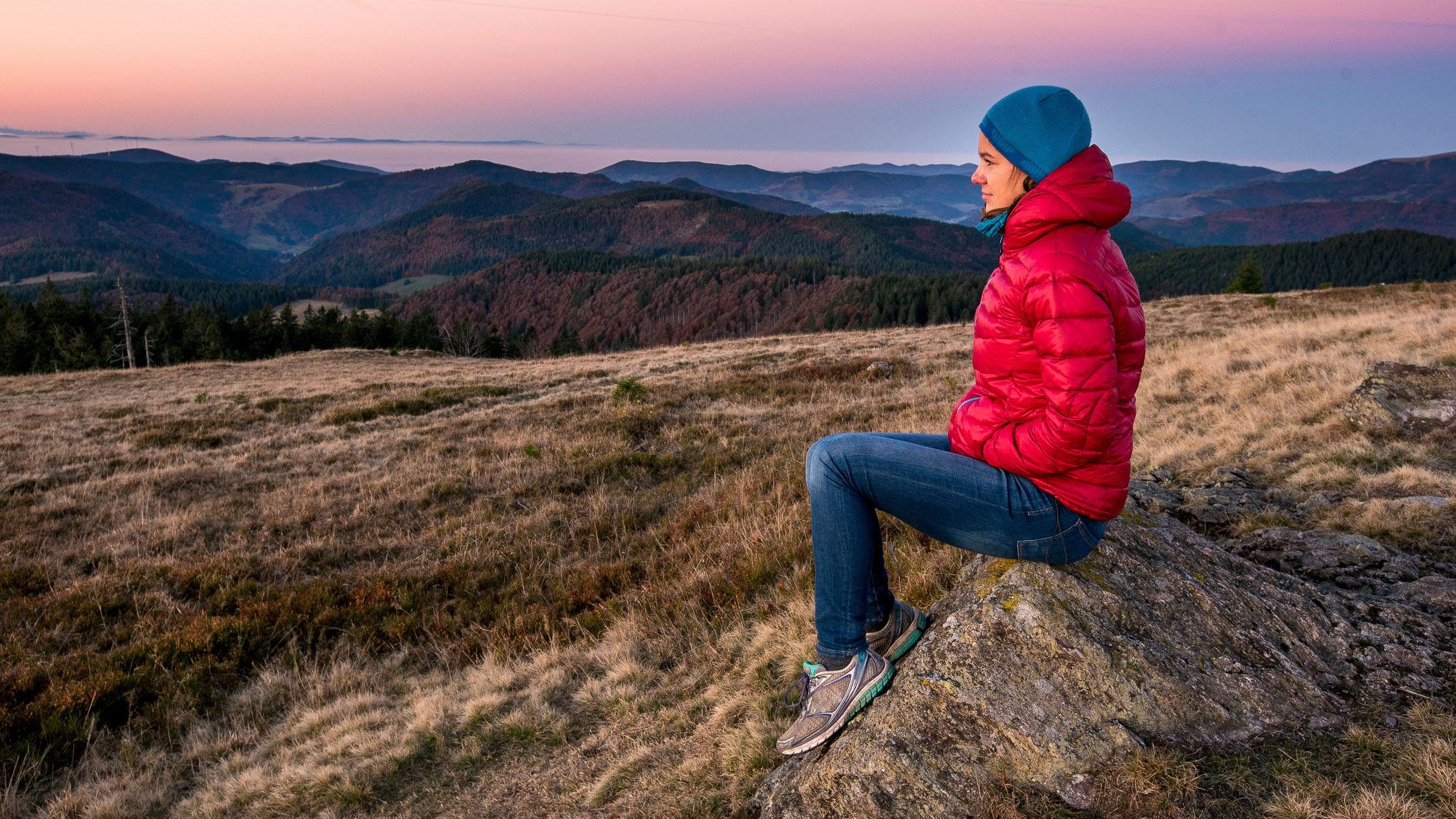
2. Design features
Many of the best women's down jackets and synthetic insulated jackets aren’t waterproof, so you’ll need to pop a waterproof shell jacket on top in heavy rain, but some are water resistant and will withstand a light shower or snowfall, and are thus a more versatile pick for the ever-changing great outdoors. When rain is forecast, it's worth packing your down jacket into a dry bag when you store it inside your backpack.
We look for jackets with close-fitting hoods, to keep your head warm in windy conditions, and a high neck to protect more of your face. If you want to wear your jacket for climbing or cycling, look for a helmet-compatible hood. We also recommend designs with stretchy or close-fitting cuffs and an elasticated or adjustable waistband, to keep heat in trapped around your body. Zipped pockets and internal pockets for storing your valuables are also handy.
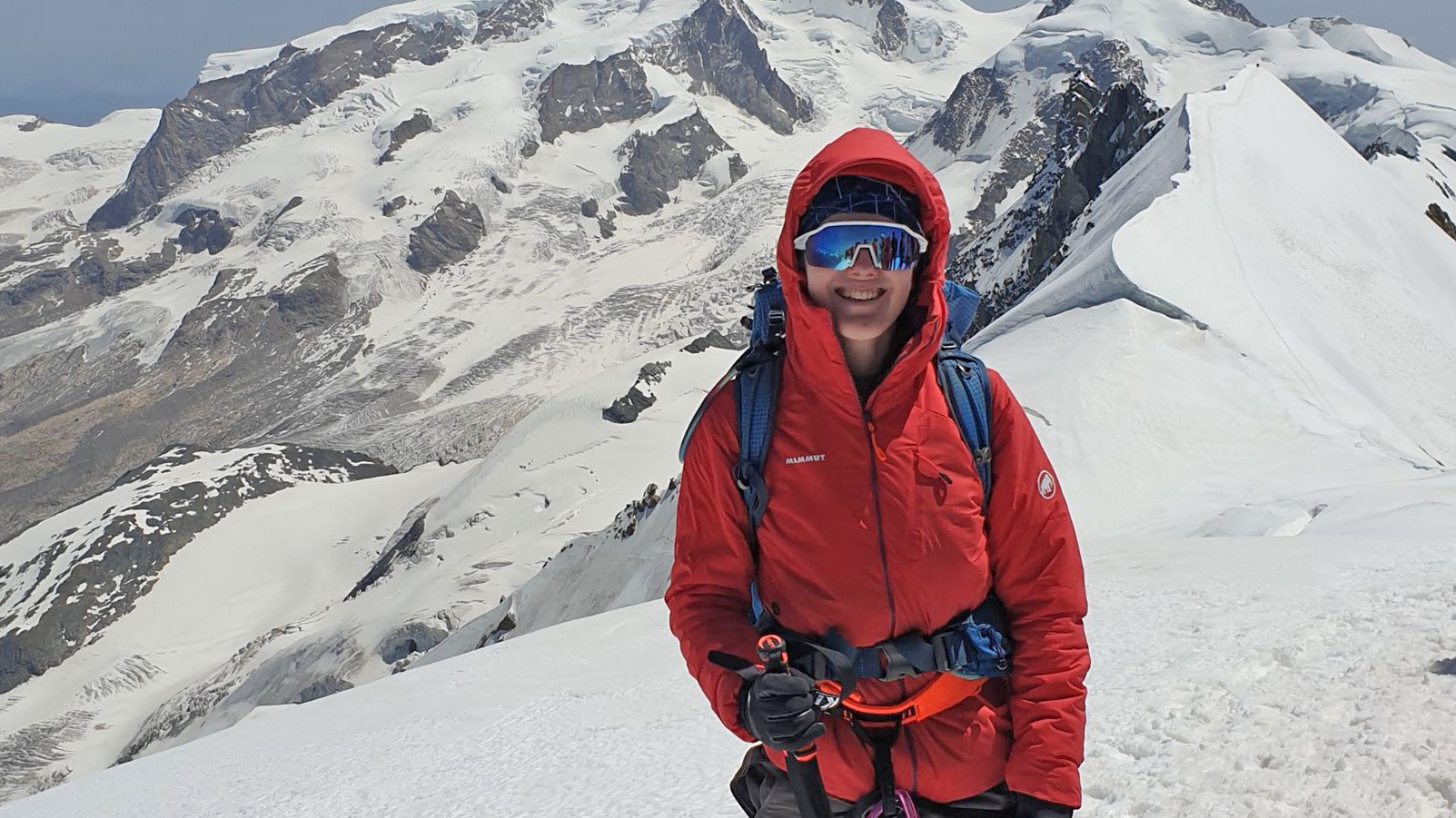
3. Packability
Insulated jackets roughly fall into two categories – lightweight and packable jackets suitable for use as mid layers, and bulky but very warm jackets that double up as coats in dry conditions but which are less easy to pack away. If you need a jacket you can stuff into your daypack (or even your pocket) when you’re out hiking or cycling, pick a packable jacket weighing under 500g that comes with a stuff bag or fits into its own pocket. If you’re after a warm jacket for bitterly cold weather and for sports where you’ll be standing still or cooling off for longer periods of time, pick a larger insulated jacket or coat.
All the latest inspiration, tips and guides to help you plan your next Advnture!
An award-winning travel and outdoors journalist, presenter and blogger, Sian regularly writes for The Independent, Evening Standard, BBC Countryfile, Coast, Outdoor Enthusiast and Sunday Times Travel. Life as a hiking, camping, wild-swimming adventure-writer has taken her around the world, exploring Bolivian jungles, kayaking in Greenland, diving with turtles in Australia, climbing mountains in Africa and, in Thailand, learning the hard way that peeing on a jellyfish sting doesn’t help. Her blog, thegirloutdoors.co.uk, champions accessible adventures.
- Emily Woodhouse
- Jessie Leong
- Kim FullerAdvnture contributor
- Fiona RussellOutdoor writer
